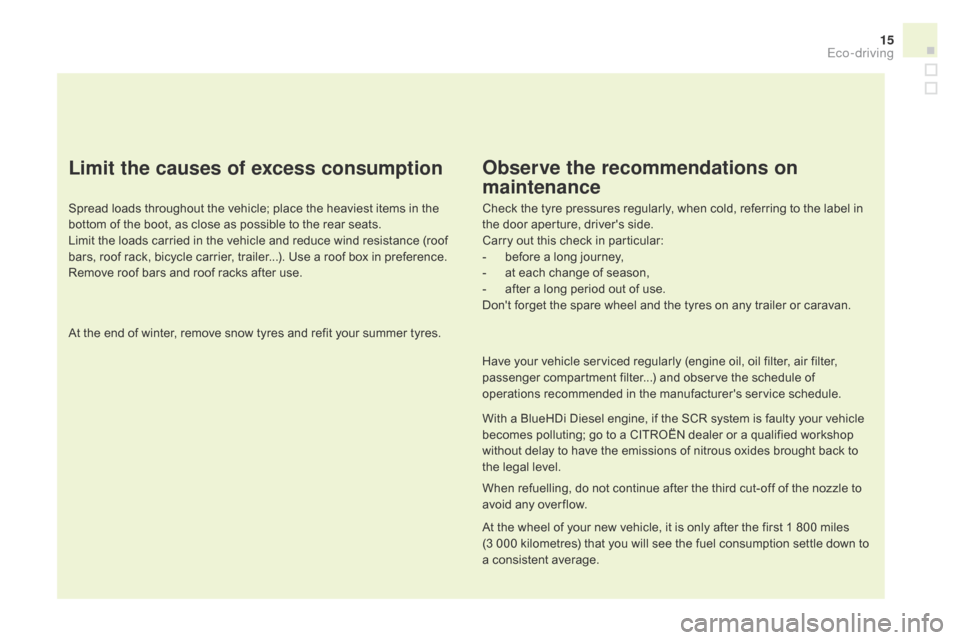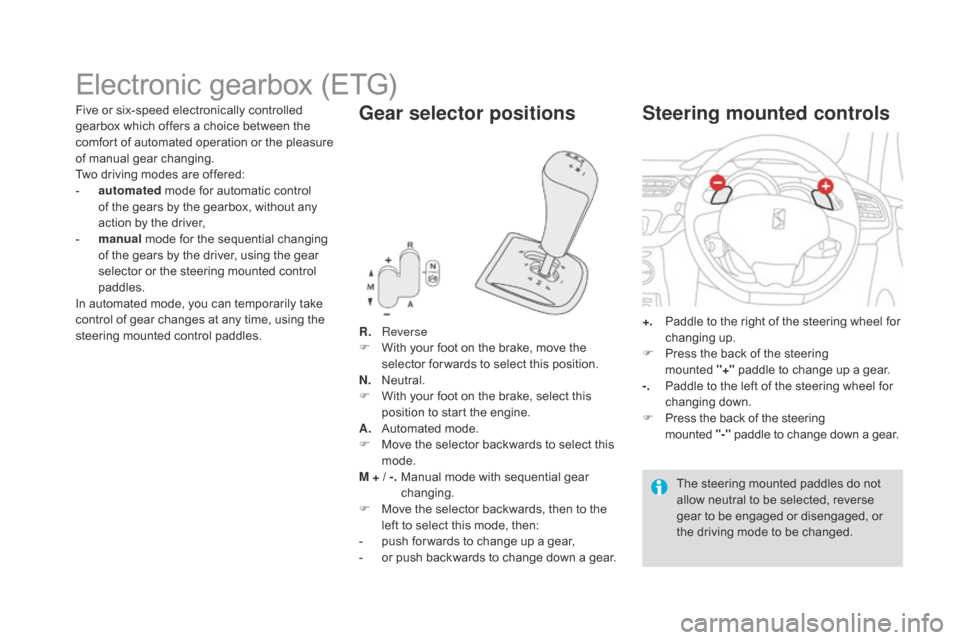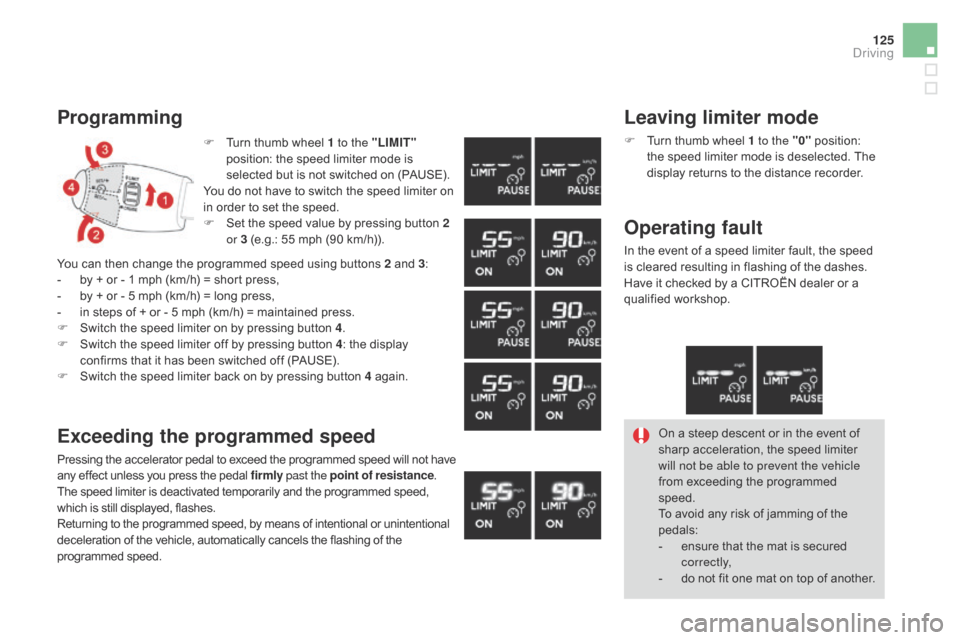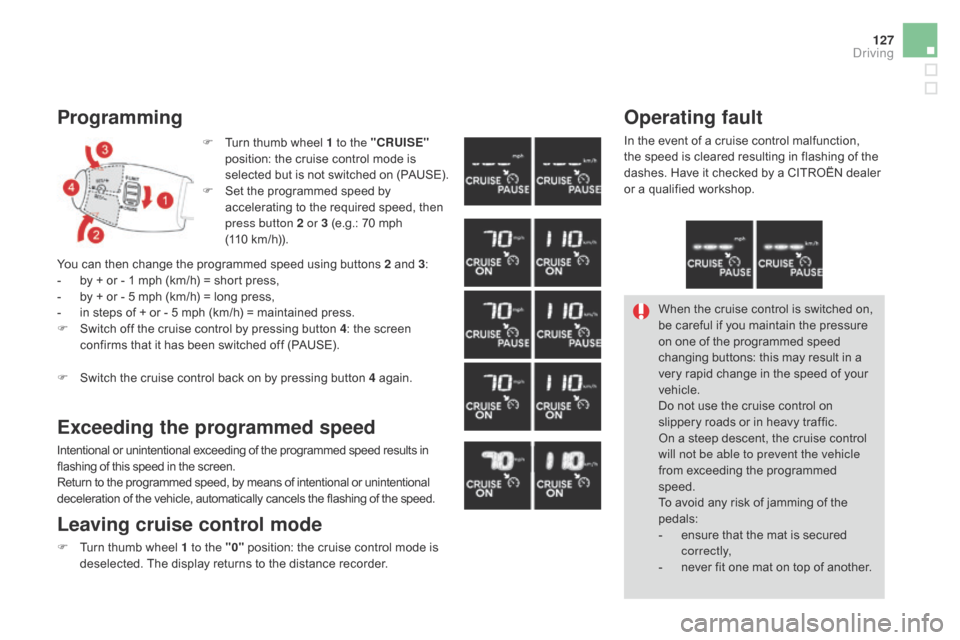change wheel Citroen DS3 RHD 2015 1.G Owner's Manual
[x] Cancel search | Manufacturer: CITROEN, Model Year: 2015, Model line: DS3 RHD, Model: Citroen DS3 RHD 2015 1.GPages: 387, PDF Size: 12.26 MB
Page 17 of 387

15
Limit the causes of excess consumption
Spread loads throughout the vehicle; place the heaviest items in the bottom of the boot, as close as possible to the rear seats.
Limit
the loads carried in the vehicle and reduce wind resistance (roof
b
ars, roof rack, bicycle carrier, trailer...). Use a roof box in preference.
Remove
roof bars and roof racks after use.
At
the end of winter, remove snow tyres and refit your summer tyres.
Observe the recommendations on
maintenance
Check the tyre pressures regularly, when cold, referring to the label in the door aperture, driver's side.
Carry
out this check in particular:
-
b
efore a long journey,
-
a
t each change of season,
-
a
fter a long period out of use.
Don't
forget the spare wheel and the tyres on any trailer or caravan.
Have
your vehicle serviced regularly (engine oil, oil filter, air filter,
p
assenger compartment filter...) and observe the schedule of
o
perations recommended in the manufacturer's service schedule.
With
a BlueHDi Diesel engine, if the SCR system is faulty your vehicle
b
ecomes polluting; go to a CITROËN dealer or a qualified workshop
w
ithout delay to have the emissions of nitrous oxides brought back to
t
he legal level.
When
refuelling, do not continue after the third cut-off of the nozzle to
a
void any over flow.
At
the wheel of your new vehicle, it is only after the first 1 800 miles
(
3 000 kilometres) that you will see the fuel consumption settle down to
a
consistent average.
Eco-driving
Page 112 of 387

Electronic gearbox (ETG)
R. Reverse
F W ith your foot on the brake, move the
s
elector for wards to select this position.
n.
N
eutral.
F
W
ith your foot on the brake, select this
p
osition to start the engine.
A.
A
utomated mode.
F
M
ove the selector backwards to select this
m
ode.
M + / -.
M
anual mode with sequential gear
c
hanging.
F
M
ove the selector backwards, then to the
l
eft to select this mode, then:
-
p
ush for wards to change up a gear,
-
o
r push backwards to change down a gear.
gear selector positions
+. Paddle to the right of the steering wheel for c
hanging u p.
F
P
ress the back of the steering
m
ounted "+" paddle
to change up a gear.
-.
P
addle to the left of the steering wheel for
c
hanging
d
own.
F
P
ress the back of the steering
m
ounted "-" paddle
to change down a gear.
Steering mounted controls
The steering mounted paddles do not allow neutral to be selected, reverse
g
ear to be engaged or disengaged, or
t
he driving mode to be changed.
Five
or
six-speed
electronically
controlled
g
earbox
which
offers
a
choice
between
the
c
omfort
of
automated
operation
or
the
pleasure
o
f
m
anual
g
ear
c
hanging.
Two
driving
modes
are
offered:
-
a
utomated
mode
for
automatic
control
o
f
the
gears
by
the
gearbox,
without
any
a
ction
by
the
driver,
-
m
anual
mode
for
the
sequential
changing
o
f
the
gears
by
the
driver,
using
the
gear
s
elector
or
the
steering
mounted
control
p
addles.
In
automated
mode,
you
can
temporarily
take
c
ontrol
of
gear
changes
at
any
time,
using
the
s
teering
mounted
control
paddles.
Page 127 of 387

125
F Turn thumb wheel 1 to the "LIMIT"
position: the speed limiter mode is
s
elected but is not switched on (PAUSE).
You
do not have to switch the speed limiter on
i
n order to set the speed.
F
S
et the speed value by pressing button 2
or 3
(e.g.: 55 mph (90 km/h)).
Programming
You can then change the programmed speed using buttons 2 and 3:
- b y + or - 1 mph (km/h) = short press,
-
b
y + or - 5 mph (km/h) = long press,
-
i
n steps of + or - 5 mph (km/h) = maintained press.
F
S
witch the speed limiter on by pressing button 4.
F
S
witch the speed limiter off by pressing button 4:
the display
c
onfirms that it has been switched off (PAUSE).
F
S
witch the speed limiter back on by pressing button 4
ag
ain.
Exceeding the programmed speed
Pressing the accelerator pedal to exceed the programmed speed will not have any effect unless you press the pedal firmly past the point of resistance .
The
speed limiter is deactivated temporarily and the programmed speed,
w
hich is still displayed, flashes.
Returning
to the programmed speed, by means of intentional or unintentional
d
eceleration of the vehicle, automatically cancels the flashing of the
pro
grammed
s
peed. On
a steep descent or in the event of s
harp acceleration, the speed limiter w
ill not be able to prevent the vehicle
from
exceeding the programmed
s
peed.
To
avoid any risk of jamming of the
ped
als:
-
e
nsure that the mat is secured
c
o r r e c t l y,
-
d
o not fit one mat on top of another.
Leaving limiter mode
F Turn thumb wheel 1 to the "0" position: t
he speed limiter mode is deselected. The
d
isplay returns to the distance recorder.
Operating fault
In the event of a speed limiter fault, the speed is cleared resulting in flashing of the dashes.
Have
it checked by a CITROËN dealer or a
q
ualified
w
orkshop.
driving
Page 129 of 387

127
Programming
F Turn thumb wheel 1 to the "CRUISE"
position: the cruise control mode is
s
elected but is not switched on (PAUSE).
F
S
et the programmed speed by
a
ccelerating to the required speed, then
p
ress button 2 or 3 (e.g.: 70 mph
(110
km/h)).
You
can
then
change
the
programmed speed using buttons 2 and 3:
-
b
y
+
or
-
1
mph
(km/h)
= short press,
-
b
y
+
or
-
5
mph
(km/h)
= long press,
-
i
n
steps
of
+
or
-
5
mph (km/h) = maintained press.
F
S
witch
off
the
cruise
control by pressing button 4:
the screen
c
onfirms
that
it
has
been switched off (PAUSE).
F
S
witch
the
cruise
control back on by pressing button 4
ag
ain.
Exceeding the programmed speed
Intentional or unintentional exceeding of the programmed speed results in flashing of this speed in the screen.
Return
to the programmed speed, by means of intentional or unintentional
d
eceleration of the vehicle, automatically cancels the flashing of the speed.
Leaving cruise control mode
F Turn thumb wheel 1 to the "0" position: the cruise control mode is d
eselected. The display returns to the distance recorder.
Operating fault
In the event of a cruise control malfunction, the speed is cleared resulting in flashing of the
d
ashes. Have it checked by a CITROËN dealer
o
r a qualified workshop.
When
the cruise control is switched on,
b
e careful if you maintain the pressure
o
n one of the programmed speed
c
hanging buttons: this may result in a
v
ery rapid change in the speed of your
v
ehicle.
Do
not use the cruise control on
s
lippery roads or in heavy traffic.
On
a steep descent, the cruise control
w
ill not be able to prevent the vehicle
from
exceeding the programmed
s
peed.
To
avoid any risk of jamming of the
ped
als:
-
e
nsure that the mat is secured
c
o r r e c t l y,
-
n
ever fit one mat on top of another.
driving
Page 152 of 387

Under-inflation detection
System which automatically checks the pressures of the tyres while driving.
T he under-inflation detection system
d
oes not replace the need for vigilance
o
n the part of the driver.
This
system does not avoid the need to
c
heck the tyre pressures (including the
s
pare wheel) every month as well as
b
efore a long journey.
Driving
with under-inflated tyres
i
mpairs road holding, extends braking
d
istances and causes premature
t
yre wear, particularly under arduous
c
ondition (high loading, high speed,
lon
g
jo
urney).The
inflation pressures defined for
y
our vehicle can be found on the tyre
p
ressure label.
See
the "Identification markings"
s
ection.
Tyre
pressures should be checked
w
hen the tyres are "cold" (vehicle
s
topped for 1 hour or after a journey of
l
ess than 6 miles (10 km) at moderate
s
peeds).
Other wise
(when hot), add 0.3 bar to
t
he pressures shown on the label.
Driving
with under-inflated tyres
i
ncreases fuel consumption.
The
system monitors the pressures in the four
t
yres, once the vehicle is moving.
It
compares the information given by the four
w
heel speed sensors with reference values,
which must be reinitialised ever y time the
tyre pressures are adjusted or a wheel
changed .
The
system triggers an alert as soon as it
d
etects a drop in the inflation pressure of one
o
r more tyres.
Page 210 of 387

F Position the foot of the jack 2 on the ground a
nd ensure that it is directly below the
f
ront A or rear B jacking point provided on
t
he underbody, whichever is closest to the
w
heel to be changed.
O
n vehicles fitted with sill finishers, the
j
acking location is indicated by a marking
o
n the finisher. The jack must be placed
c
entrally in line with this marking, at the
j
acking point located behind the finisher
a
nd not on the plastic finisher itself. F
R emove the bolts and store them in a clean p
lace.
F
R
emove the wheel.
F
E xtend the jack 2 until its head comes into c
ontact with the jacking point A or B used.
T
he contact area A or B on the vehicle
must
be engaged with the central part of
t
he head of the jack.
F
Ra
ise the vehicle until there is sufficient
space
between the wheel and the ground
s
o that the spare (not punctured) wheel can
t
hen be fitted without difficulty.